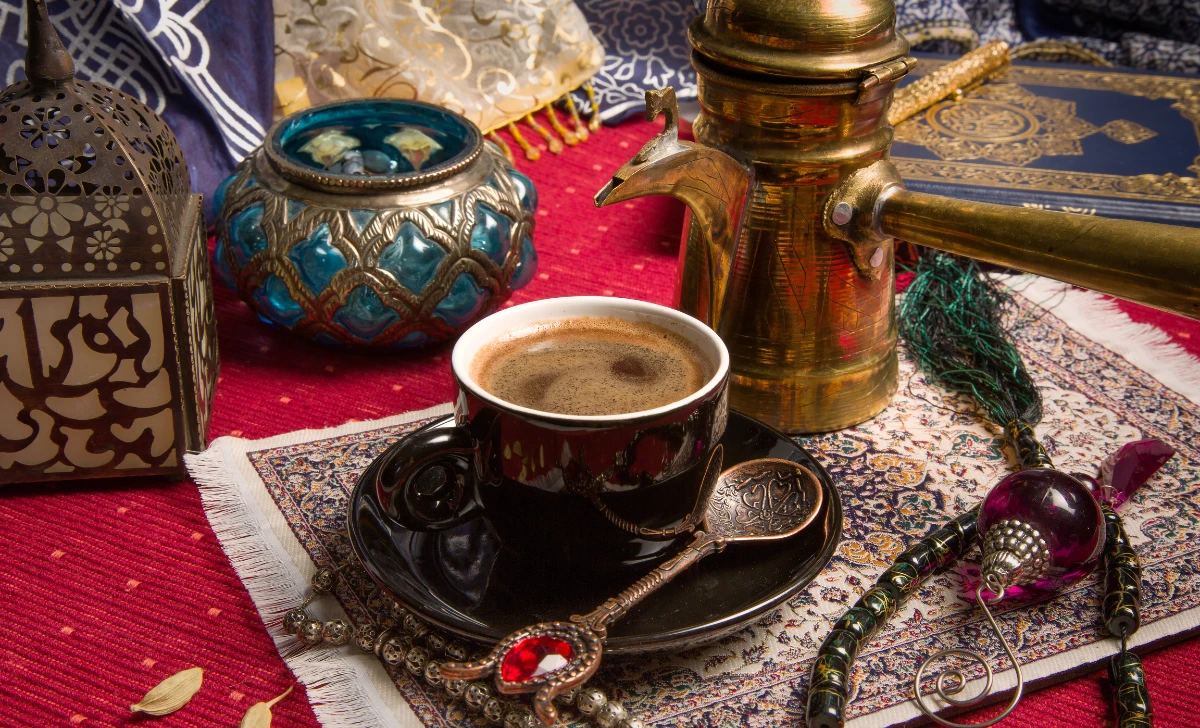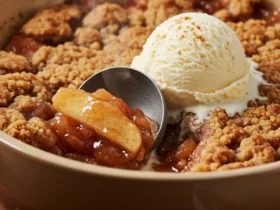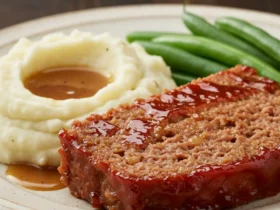Arabic coffee, also known as “qahwa arabiyya” or “gahwa,” is a cultural gem deeply rooted in Middle Eastern traditions. This aromatic beverage goes beyond being a mere drink; it’s a symbol of hospitality and connection. Join us on a delightful journey as we explore the rich history and the art of making Arabic coffee.
[ez-toc]
History
The aromatic journey of Arabic coffee, known as “qahwa arabiyya” or “gahwa,” is a tale woven through centuries of tradition and cultural exchanges. This beloved brew’s history is a testament to its enduring significance and the connections it has forged across borders.
Origins in the Arabian Sands
The story of Arabic coffee begins in the deserts of the Arabian Peninsula, where coffee cultivation and consumption emerged as a cultural practice. Coffee beans were first discovered in Ethiopia, and their journey to the Arabian Peninsula marked the start of a revolution in the way people experienced this humble bean.
The Yemeni Discovery
In the 15th century, the mystique of coffee was unlocked by the Yemenis, who began cultivating coffee plants in the region. The Arab world quickly recognized the potential of these beans, not only for their stimulating properties but also for the rich flavors they held.
The Birth of Coffeehouses
As coffee’s popularity grew, so did the emergence of coffeehouses – vibrant centers of social interaction and intellectual exchange. By the 16th century, these establishments, known as “qahveh khaneh,” dotted the landscape of the Ottoman Empire, creating spaces for people to gather, discuss, and share stories over cups of coffee.
Coffee’s Cultural Migration
Arabic coffee didn’t remain confined to its place of origin. Instead, it embarked on a global journey, carrying with it the essence of Arabian hospitality and tradition.
The Coffee Caravan
Arabic traders ventured beyond their borders, bringing coffee to Persia, North Africa, and eventually, Europe. This trade introduced the world to the enchanting brew, leaving an indelible mark on cultures far and wide.
European Fascination
The allure of coffee captivated Europe in the 17th century. Coffeehouses emerged across the continent, mirroring the coffee culture of the Middle East. These establishments became epicenters of artistic exchange, intellectual debates, and social discourse.
The Brewing Evolution
As Arabic coffee traveled, it adapted and evolved, blending with local customs and flavors to create unique variations.
Cardamom’s Entrancing Influence
The tradition of adding cardamom to Arabic coffee wasn’t just a flavor choice; it was a stroke of genius. This aromatic spice not only enriched the brew’s taste but also became a symbol of the cultural fusion that coffee represented.
Rituals and Symbolism
Brewing Arabic coffee transformed from a practical task to a cherished ritual. The dallah, finjans, and the distinct pouring method all became elements that communicated respect, generosity, and tradition.
Cultural Significance in the Modern Era
In today’s fast-paced world, Arabic coffee remains a cherished tradition that continues to bridge gaps and create connections.
Arabic Coffee Diplomacy
Arabic coffee’s role transcended homes and coffeehouses to become a tool of diplomacy. It’s often served to guests as a sign of goodwill, transcending language barriers and forming bonds between people.
Global Embrace
The cultural significance of Arabic coffee has resonated worldwide. Coffee enthusiasts and cultural explorers alike are drawn to the intricacies of the brewing process, the symbolism, and the history encapsulated in each cup.
Time
| Step | Time |
|---|---|
| Grinding and Roasting | 15 minutes |
| Brewing Process | 20 minutes |
| Serving and Savoring | 10 minutes |
| Bonding and Hospitality | Ongoing |
| Storytelling Over Coffee | Ongoing |
| Total Preparation and Cooking | Approx. 45 minutes |
Please note that the times provided are approximate and can vary based on individual preferences and experience. The ongoing times for bonding and storytelling reflect the continuous nature of these activities that happen over the course of enjoying Arabic coffee.
Ingredients
| Ingredients | Quantity |
|---|---|
| Coffee Beans | 2 tablespoons |
| Cardamom | 1/4 teaspoon |
| Water | 1.5 cups |
| Dates (optional) | A few |
Directions
Grinding and Roasting
Step 1: Grind the Coffee Beans
- Measure 2 tablespoons of coffee beans and grind them to a medium coarseness. The sound of grinding is the prelude to a fragrant journey.
Step 2: Roasting the Beans (Optional)
- In a dry pan, lightly roast the ground coffee over low heat. This step enhances the aroma and flavor profile of the beans. Stir constantly for about 3-4 minutes until a gentle aroma arises.
Brewing Process
Step 3: Preparing the Water and Cardamom
- In a traditional dallah or a small saucepan, pour 1.5 cups of cold water.
- Add 1/4 teaspoon of ground cardamom to infuse the water with its distinctive fragrance.
Step 4: Simmering and Infusion
- Place the dallah on medium heat and let the water simmer. Allow the cardamom to infuse its essence into the water for about 5-7 minutes.
Step 5: Adding Coffee
- Gradually add the ground coffee to the simmering water and cardamom mixture.
- Gently stir the brew to ensure an even distribution of flavors.
Step 6: Foaming Stage
- As the coffee heats and simmers, it will begin to foam. This stage is crucial, as it intensifies the flavors and aromas.
Step 7: The Aroma Unveiled
- The kitchen will soon be filled with the irresistible aroma of Arabic coffee. Allow the brew to continue simmering for another 2-3 minutes.
Serving and Savoring
Step 8: The Finjan Ceremony
- Using a traditional finjan or small cups, carefully pour the brewed coffee. The long-spouted dallah adds a touch of elegance to this gesture.
Step 9: Three Sips Tradition
- Embrace the tradition: take three sips of the coffee. With each sip, you’ll journey from bitterness to the nuanced sweetness that follows.
Step 10: Pairing with Dates (Optional)
- To balance the bitterness of the coffee, consider serving it with a few fresh dates. The combination enhances the overall experience.
Equipment Required
Nutrition Information
| Nutrition Information | Per Serving |
|---|---|
| Serving Size | 1 cup |
| Calories | 5 |
| Fat | 0g |
| Protein | 0g |
| Carbohydrates | 1g |
| Fiber | 0g |
| Sugars | 0g |
| Sodium | 0mg |
| Caffeine | Approx. 30mg |
Please note that the provided values are approximate and can vary based on factors such as the specific coffee beans used and any additional ingredients added.
Tips
- Quality Matters: Opt for high-quality coffee beans to ensure the best flavor. Freshly ground beans will elevate the taste and aroma.
- Cardamom Sensation: Adjust the amount of cardamom to your taste preference. Start with a small pinch and gradually add more for a stronger cardamom flavor.
- Gentle Roasting: If roasting the coffee beans, keep the heat low and stir constantly. The goal is to enhance the aroma without burning the beans.
- Simmer Slowly: Allow the water and cardamom mixture to simmer gently. Rushing this step can result in uneven flavor infusion.
- The Foam Factor: Achieving the perfect foam takes patience. Simmer the brew on medium heat, and you’ll witness the foam forming gradually.
- Three Sips Tradition: Embrace the tradition of sipping three times. Let each sip guide you through the journey from bitter to sweet.
- Perfect Pairing: If using dates, consider adding a small piece to each sip. The combination of coffee and dates is a delightful harmony of flavors.
Pros & Cons
| Pros | Cons |
|---|---|
| ✅ Rich Tradition | ❌ Moderate caffeine content |
| ✅ Cultural Bond | ❌ Bitter taste for some |
| ✅ Aromatic Bliss | ❌ Requires special equipment |
| ✅ Social Ritual | ❌ Not suitable for those who prefer sweeter drinks |
| ✅ Low Calories | ❌ Time-consuming preparation |
Conclusion
In every cup of Arabic coffee, there’s a journey through time, culture, and the warmth of human connections. From its humble beginnings in the heart of the Arabian Peninsula to its global presence today, Arabic coffee is more than a beverage; it’s an invitation to share stories, create memories, and forge bonds that transcend borders.
As you prepare this time-honored brew, remember that each step carries within it a piece of history and tradition. The gentle aroma of cardamom, the foaming stage that builds anticipation, and the cherished three sips tradition – all of these elements come together to create an experience that’s as heartwarming as the coffee itself.
Arabic coffee’s allure lies not only in its rich flavor but in the conversations it sparks and the connections it fosters. It’s an embodiment of hospitality, an expression of respect, and a symbol of unity in a world that often seeks harmony.
So, why not take a sip of this cultural elixir? Embrace the essence of Arabic coffee and let its flavors transport you to a realm where time slows down and conversations flow freely. Whether you enjoy it alone as a moment of reflection or share it with loved ones to create new memories, Arabic coffee promises an experience that’s as enchanting as it is timeless.
Go ahead, gather your dallah, grind those beans, and let the aroma of tradition fill your space. With each sip, you’re not just tasting coffee – you’re embracing a legacy that’s waiting to be explored.
So, let the journey begin, and may your cup overflow with the warmth of Arabian hospitality and the richness of history.
Sip by sip, relish the moments, and embark on this flavorful adventure.
Facts
- Fact 1: 🌍 Global Sip, Local Name
- Did you know that Arabic coffee is known by various names around the world? In Saudi Arabia, it’s “qahwa,” in Yemen, it’s “qishr,” and in Ethiopia, where coffee beans were first discovered, it’s “bunna.” No matter the name, the spirit of tradition and connection remains the same.
- Fact 2: ☕️ The Social Sipper
- Arabic coffee isn’t just about the drink itself; it’s a symbol of hospitality and connection. In the Middle East, offering coffee to guests is an integral part of welcoming them into your home. It’s a gesture that transcends language and fosters a sense of unity.
- Fact 3: 🔢 Three Sips, Many Meanings
- The tradition of taking three sips of Arabic coffee isn’t just about taste; it’s a metaphor for life’s journey. The first sip is the bitterness of challenges, the second is the depth of experience, and the third is the sweetness of triumph. Each sip tells a story, sip by sip.
- Fact 4: 📜 A Brew with Diplomacy
- Arabic coffee has played a diplomatic role throughout history. In the Middle East, leaders would use the process of serving and drinking coffee to negotiate, discuss treaties, and establish alliances. Who knew that a cup of coffee could shape history?
- Fact 5: ☕️ Beyond Coffee Houses
- While Arabic coffeehouses are cultural hubs, did you know that Bedouins in the desert have their unique way of brewing? They use a simple pan called a “mehmasa” to make coffee over an open flame. It’s a reminder that tradition thrives in the most unexpected places.
FAQ’s
Can I use instant coffee for Arabic coffee?
While Arabic coffee traditionally uses freshly ground coffee beans, you can experiment with instant coffee. However, keep in mind that the flavor and aroma might differ from the traditional brew.
Is Arabic coffee suitable for vegetarians and vegans?
Yes, Arabic coffee is typically vegetarian and vegan-friendly. Just ensure that any optional additives, like milk or sweeteners, align with your dietary preferences.
Can I make Arabic coffee with a coffee machine?
Arabic coffee is traditionally prepared using a dallah or a small saucepan. While a coffee machine isn’t traditional, you can adapt the process by using the machine’s espresso function for brewing and adding cardamom separately.
How do I adjust the bitterness of Arabic coffee?
The bitterness level can be adjusted by altering the coffee-to-water ratio. Adding a bit more water can dilute the bitterness, while experimenting with different coffee beans can also impact the taste.
Can I make Arabic coffee without cardamom?
Yes, you can omit cardamom if you prefer. It’s a traditional spice used for flavor, but you can still enjoy the brewing process without it.
Can I reheat leftover Arabic coffee?
It’s best to avoid reheating Arabic coffee as it may affect the flavor and aroma. Instead, brew a fresh batch when you’re ready to enjoy it.
What’s the significance of the foaming stage?
The foaming stage is crucial for Arabic coffee as it intensifies the flavors and aromas, creating a richer and more well-rounded taste.
Can I use a regular teapot instead of a dallah?
While a dallah is traditional, you can use a regular teapot if needed. The key is to maintain the essence of the process and its cultural significance.
Can I serve Arabic coffee with a dessert other than dates?
Absolutely! While dates are traditional, you can pair Arabic coffee with a variety of desserts like baklava, ma’amoul, or even chocolate.
How can I make Arabic coffee less bitter without diluting it?
If you prefer a milder flavor, try using a lighter roast of coffee beans. Additionally, adjusting the brewing time and using slightly cooler water can also reduce bitterness without dilution.












Leave a Review